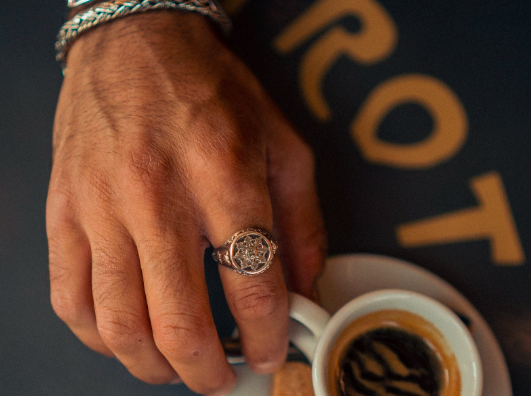For centuries, jewelry has carried meaning—symbols of wealth, power, love, and legacy. Yet somewhere along the modern timeline, much of that symbolism for men faded. Rings, chains, and bracelets became either strictly functional (like wedding bands or watches) or confined to specific cultural expressions.
But over the past few years, something interesting has happened: men are once again embracing jewelry—not just as adornment, but as a form of identity. From minimalist pieces in brushed gold to bold statement rings worn by artists and athletes alike, fine jewelry for men is reemerging in fashion, culture, and design.
The question is, does this shift represent a new form of masculinity—or a return to something timeless?
The Cultural Pendulum: From Status to Subtlety and Back Again
Historically, men’s jewelry has always existed—it simply went through cycles of visibility. Ancient pharaohs, Roman emperors, and European kings wore gold, gemstones, and intricate metalwork to signify rank and influence. Rings weren’t merely decorative; they sealed documents, represented family lineage, or marked allegiance.
The industrial era changed that. As modern work demanded practicality and uniformity, jewelry became secondary to function. A man’s identity was increasingly defined by his role, not his ornamentation. The wristwatch survived this shift because it blended purpose with prestige, but other jewelry—especially rings—became rarer.
Now, the pendulum has swung again. Contemporary men are reclaiming adornment as self-expression. And rather than undermining masculinity, it’s redefining it.
The Modern Man’s Aesthetic Confidence
One of the clearest signs of this shift is aesthetic confidence. Men today are less concerned about conforming to rigid definitions of appearance and more focused on authenticity. Jewelry, in this sense, isn’t about opulence—it’s about intention.
Consider the subtle ring worn by an entrepreneur, crafted in muted yellow gold to complement his minimalist style. Or the bold, oversized piece favored by a musician, engraved with symbols that tell his personal story. These choices reflect individuality, not extravagance.
The rise of digital culture and visual storytelling (from Instagram to red carpets) has accelerated this evolution. Exposure to global fashion trends has normalized diversity in masculine style, making jewelry an accessible form of self-definition rather than rebellion.
In short, men aren’t wearing jewelry to stand out anymore—they’re wearing it because it fits who they are.
The Psychology of Adornment
Jewelry carries a psychological dimension often overlooked in conversations about fashion. It’s tactile, symbolic, and deeply personal. A ring can represent achievement, faith, heritage, or even transformation.
For men, especially in cultures that traditionally limited emotional expression, jewelry offers a quiet way to communicate meaning. A ring may signify a milestone, a family legacy, or a self-made identity. The material itself—gold, platinum, or titanium—often carries emotional resonance, connecting its wearer to heritage and endurance.
There’s also something empowering about the physicality of metal on skin—a reminder of weight, permanence, and craftsmanship in an increasingly digital world. Wearing jewelry isn’t vanity—it’s presence.
The Masculinity Debate: Tradition vs. Progress
When conversations about men’s jewelry arise, so too do debates about masculinity. Historically, Western culture framed minimalism as masculine restraint and adornment as vanity. That dichotomy is fading fast.
Today’s definition of masculinity is broader, more inclusive, and far more complex. It’s no longer defined by what men avoid—color, shine, softness—but by how they choose to express confidence, values, and creativity.
Jewelry, therefore, becomes a medium for modern masculinity rather than a threat to it. In fact, the return of gold, silver, and handcrafted accessories signals a cultural reconciliation—between strength and style, restraint and expression, history and innovation.
Athletes, actors, and designers have played a major role in shifting public perception. Figures like LeBron James, Timothée Chalamet, and Harry Styles have normalized men’s jewelry as both high fashion and personal storytelling. These influences filter down, giving everyday men permission to experiment.
When seen in this light, jewelry doesn’t feminize masculinity—it humanizes it.
Craftsmanship Returns to the Spotlight
This revival isn’t just aesthetic; it’s also artisanal. As fast fashion loses its appeal, craftsmanship is making a comeback. Consumers are seeking authenticity—handmade pieces with visible care and traceable origins.
In men’s fine jewelry, this means a renewed interest in small-batch goldsmiths, ethical sourcing, and custom design. A handcrafted ring can be a piece of art, a symbol of sustainability, and a personal signature all at once.
Among these, gold rings for men have become the centerpiece of the modern jewelry movement—not for their flash, but for their timelessness. Gold has an unmatched ability to feel both ancient and modern, ceremonial and everyday. It’s a material that evolves with its wearer, developing subtle patina and character over time.
Minimalism Meets Meaning
Interestingly, as men embrace jewelry again, their approach leans toward minimalism. Rather than collecting dozens of pieces, many choose one or two meaningful items and wear them consistently.
This intentional simplicity reflects a broader cultural trend: the move toward “quiet luxury.” Instead of conspicuous branding, men favor understated elegance—quality over quantity, story over spectacle. A single gold ring or bracelet becomes a cornerstone of identity, not an accessory to it.
This minimalist approach also transcends generations. A modern professional in his thirties and a retiree in his seventies might both wear the same understated band for entirely different reasons—but both find meaning in its permanence.
Beyond Fashion: The New Heritage
The most powerful aspect of this resurgence is that it feels enduring. While trends come and go, the reemergence of men’s jewelry—particularly fine, meaningful pieces—represents something more stable: a return to heritage.
As men rethink how they express success, love, and individuality, they’re rediscovering the symbolic language of adornment. Rings, once dismissed as outdated or ornamental, are becoming the heirlooms of tomorrow.
And perhaps that’s the real story here: not that men are wearing jewelry again, but that they’re choosing pieces designed to last—to be passed down, not discarded.
The Bottom Line
The resurgence of men’s fine jewelry isn’t about fashion—it’s about freedom. Freedom to define one’s image without apology. Freedom to blend strength with subtlety. Freedom to make choices guided by meaning rather than convention.
This evolution doesn’t challenge masculinity; it expands it.
Gold rings, bracelets, and chains are no longer mere symbols of wealth or vanity—they’re artifacts of individuality, markers of connection, and reflections of how men see themselves in a changing world.
And as more men embrace this quiet revolution, the line between tradition and self-expression becomes beautifully blurred.









